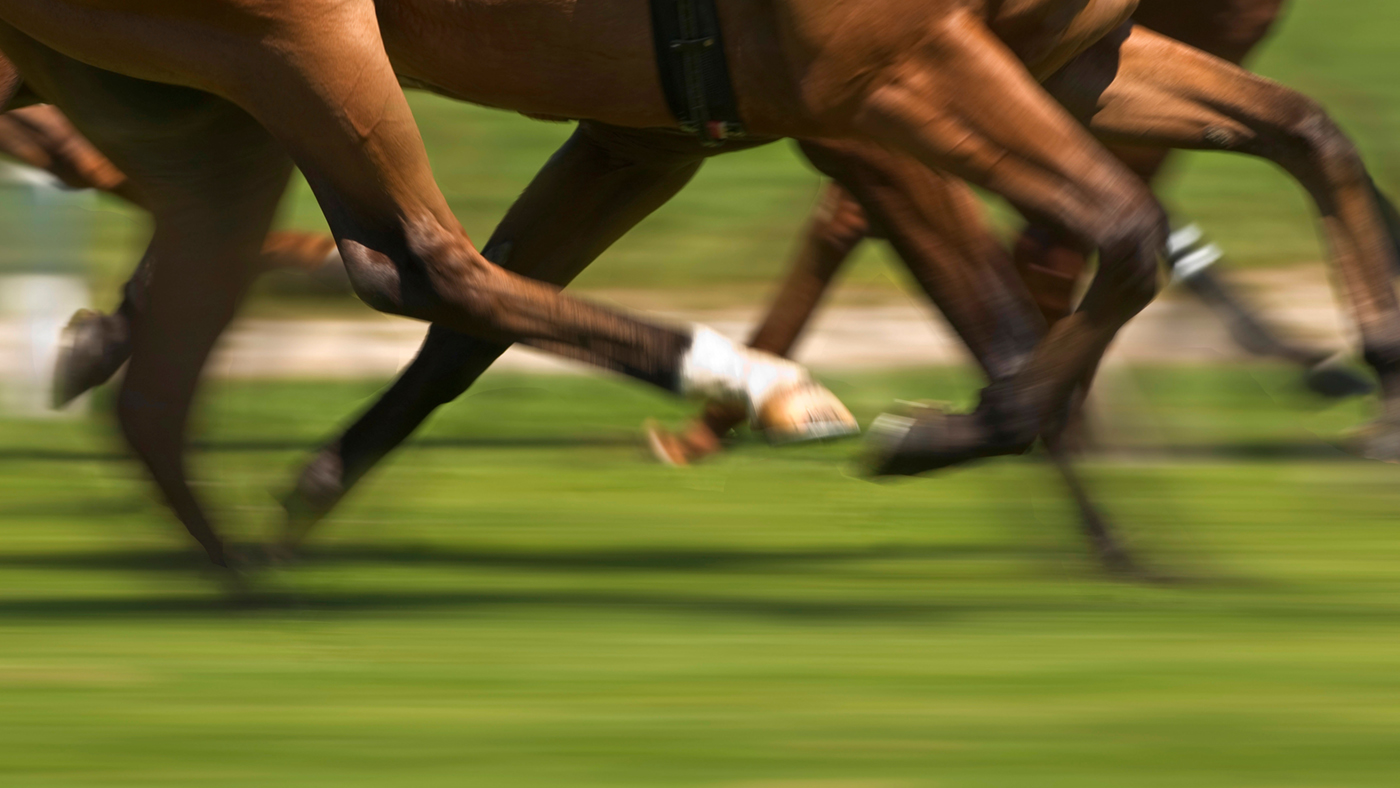Sharp contact between a horse’s hind hoof and foreleg can cause a significant injury, as Dr David Stack MRCVS explains
OVERREACH and strike wounds – known as interference injuries – are often self-inflicted. An overreach typically occurs when a horse steps on the heels of a forelimb with a hind foot, while a strike wound can result from the edge of the hoof or shoe making sharp contact with the fetlock or pastern region.
Similar incidents can occur when there is contact between the limbs of two horses moving in close proximity. Injuries can range from minor grazes and bruises that can be managed with routine first aid, to issues requiring veterinary attention. Some can be severe, leading to referral, hospitalisation and even surgery.
Injury can happen at any time in any horse moving actively – often at moments when the gait becomes uncoordinated, due to a lapse of concentration or a loss of fine motor control due to fatigue. Fatigue-related interference injuries can also occur in heavy ground, where horses tire quickly.
{"content":"PHA+V2Ugb2Z0ZW4gc2VlIGludGVyZmVyZW5jZSBpc3N1ZXMgd2l0aCA8YSBocmVmPSJodHRwczovL3d3dy5ob3JzZWFuZGhvdW5kLmNvLnVrL3BsdXMvd29iYmxlci1zeW5kcm9tZS1pbi1ob3JzZXMtNTAxMzY4Ij53b2JibGVyIHN5bmRyb21lLDwvYT4gd2hlcmUgYSBob3JzZSBsb3NlcyB0aGUgYWJpbGl0eSB0byBrbm93IHdoZXJlIGhpcyBsaW1icyBhcmUgaW4gc3BhY2UgKGEgc2Vuc2Uga25vd24gYXMgcHJvcHJpb2NlcHRpb24pLiBUaGlzIGNhbiBjYXVzZSBhbiBpcnJlZ3VsYXIgYW5kIHVuY29vcmRpbmF0ZWQgc3RyaWRlLCBsZWFkaW5nIHRvIGZyZXF1ZW50IG92ZXJyZWFjaCBpbmp1cmllcy48L3A+CjxwPlN0cmlrZXMgb3Igc2hhcnAsIGdsYW5jaW5nIGJsb3dzIGZyb20gYW55IG90aGVyIGxpbWIgdGVuZCB0byByZXN1bHQgaW4gbGFjZXJhdGlvbnMsIG9mdGVuIGluIGEgaG9yaXpvbnRhbCBwbGFuZSwgb24gdGhlIHNpZGVzIG9yIGJhY2sgb2YgdGhlIHBhc3Rlcm4gb3IgZmV0bG9jay4gT3ZlcnJlYWNoIGluanVyaWVzIHR5cGljYWxseSBjYXVzZSBpcnJlZ3VsYXIgc2tpbiB0ZWFycyB0aGF0IGNhbiBwZW5ldHJhdGUgb3RoZXIgdGlzc3VlcyBvZiB0aGUgaGVlbCwgZXZlbiByaXBwaW5nIHRoZSBjb3JvbmFyeSBiYW5kLjwvcD4KPHA+PGRpdiBjbGFzcz0iYWQtY29udGFpbmVyIGFkLWNvbnRhaW5lci0tbW9iaWxlIj48ZGl2IGlkPSJwb3N0LWlubGluZS0yIiBjbGFzcz0iaXBjLWFkdmVydCI+PC9kaXY+PC9kaXY+PHNlY3Rpb24gaWQ9ImVtYmVkX2NvZGUtMzEiIGNsYXNzPSJoaWRkZW4tbWQgaGlkZGVuLWxnIHMtY29udGFpbmVyIHN0aWNreS1hbmNob3IgaGlkZS13aWRnZXQtdGl0bGUgd2lkZ2V0X2VtYmVkX2NvZGUgcHJlbWl1bV9pbmxpbmVfMiI+PHNlY3Rpb24gY2xhc3M9InMtY29udGFpbmVyIGxpc3RpbmctLXNpbmdsZSBsaXN0aW5nLS1zaW5nbGUtc2hhcmV0aHJvdWdoIGltYWdlLWFzcGVjdC1sYW5kc2NhcGUgZGVmYXVsdCBzaGFyZXRocm91Z2gtYWQgc2hhcmV0aHJvdWdoLWFkLWhpZGRlbiI+DQogIDxkaXYgY2xhc3M9InMtY29udGFpbmVyX19pbm5lciI+DQogICAgPHVsPg0KICAgICAgPGxpIGlkPSJuYXRpdmUtY29udGVudC1tb2JpbGUiIGNsYXNzPSJsaXN0aW5nLWl0ZW0iPg0KICAgICAgPC9saT4NCiAgICA8L3VsPg0KICA8L2Rpdj4NCjwvc2VjdGlvbj48L3NlY3Rpb24+PC9wPgo8cD5FaXRoZXIgdHlwZSBvZiBpbmp1cnkgY2FuIGhhdmUgc2VyaW91cyBjb25zZXF1ZW5jZXMsIGlycmVzcGVjdGl2ZSBvZiB0aGUgc2l6ZSBvZiB0aGUgd291bmQuIExpa2Ugb3RoZXIgcHJleSBzcGVjaWVzLCBob3JzZXMgaGF2ZSB2ZXJ5IGxpdHRsZSBtdXNjbGUsIGZhdCBvciBsb29zZSwgY29ubmVjdGl2ZSB0aXNzdWUgYmVsb3cgdGhlIGNhcnB1cyAoa25lZSkgb3IgdGFyc3VzIChob2NrKS4gVGhpcyBldm9sdXRpb25hcnkgY2hhcmFjdGVyaXN0aWMgaW1wcm92ZXMgdGhlIHNwZWVkIGFuZCBlZmZpY2llbmN5IHdpdGggd2hpY2ggYSBob3JzZSBtb3ZlcywgYnkgcmVkdWNpbmcgdGhlIHdlaWdodCBvZiB0aGUgbG93ZXIgbGltYiwgYnV0IGxlYXZlcyB2aXRhbCB0aXNzdWVzIHZ1bG5lcmFibGUgdG8gdHJhdW1hLjwvcD4KPHA+VGhlIGpvaW50cyBhbmQgYm9uZXMgYXJlIHJlbGF0aXZlbHkgdW5wcm90ZWN0ZWQsIGFzIGFyZSB0aGUgbGlnYW1lbnRzIGFuZCBjYXJ0aWxhZ2UgYW5kIHRoZSBjdXNoaW9uaW5nLCBmbHVpZC1maWxsZWQgYnVyc2FlLiBOZXJ2ZXMsIGJsb29kIHZlc3NlbHMsIHRlbmRvbnMgYW5kIHRlbmRvbiBzaGVhdGhzIGFyZSBhbHNvIGF0IHJpc2suPC9wPgo8aDM+V2hhdOKAmXMgdGhlIGRhbWFnZTwvaDM+CjxwPklGIHlvdXIgaG9yc2Ugc3VzdGFpbnMgYSBzdHJpa2Ugb3Igb3ZlcnJlYWNoIGluanVyeSwgY29udGFjdCB5b3VyIHZldC4gRXZlbiBzZWVtaW5nbHkgaW5ub2N1b3VzIGluanVyaWVzIGNhbiBoYXZlIHNlcmlvdXMgY29uc2VxdWVuY2VzLCBpbmNsdWRpbmcgaW5mZWN0aW9uIG9mIHRoZSBzeW5vdmlhbCAoam9pbnQpIGZsdWlkLjwvcD4KPGRpdiBjbGFzcz0iYWQtY29udGFpbmVyIGFkLWNvbnRhaW5lci0tbW9iaWxlIj48ZGl2IGlkPSJwb3N0LWlubGluZS0zIiBjbGFzcz0iaXBjLWFkdmVydCI+PC9kaXY+PC9kaXY+CjxwPldvdW5kcyB0aGF0IGFyZSBibGVlZGluZyBwcm9mdXNlbHkgc2hvdWxkIGJlIGJhbmRhZ2VkIGNhcmVmdWxseSBidXQgc251Z2x5LCB3aXRoIGRpcmVjdCBwcmVzc3VyZSBvdmVyIHRoZSB3b3VuZC4gQSBwcmVzc3VyZSBiYW5kYWdlIHNob3VsZCBub3QgYmUgbGVmdCBpbiBwbGFjZSBmb3IgbW9yZSB0aGFuIHR3byB0byB0aHJlZSBob3VycywgYnV0IGNhbiBiZSByZXBsYWNlZCBpZiBibG9vZCBmbG93IGNvbnRpbnVlcy48L3A+CjxwPkFsbCBvdGhlciB3b3VuZHMgc2hvdWxkIGJlIHJpbnNlZCBsaWJlcmFsbHkgd2l0aCBmcmVzaCB0YXAgd2F0ZXIgZm9yIGZpdmUgdG8gMTAgbWludXRlcywgYW5kIHRoZW4gYSBjbGVhbiwgZHJ5IGJhbmRhZ2UgYXBwbGllZC4gQXZvaWQgdG91Y2hpbmcgdGhlIHNpdGUgd2l0aCB1bmdsb3ZlZCBmaW5nZXJzIGFuZCByZW1lbWJlciB0aGF0IGEgcG91bHRpY2UgaXMgbm90IGEgc3VpdGFibGUgZHJlc3NpbmcgZm9yIGEgd291bmQuPC9wPgo8ZGl2IGNsYXNzPSJhZC1jb250YWluZXIgYWQtY29udGFpbmVyLS1tb2JpbGUiPjxkaXYgaWQ9InBvc3QtaW5saW5lLTQiIGNsYXNzPSJpcGMtYWR2ZXJ0Ij48L2Rpdj48L2Rpdj4KPHA+SWYgdGhlIHNraW4gaXMgbGFjZXJhdGVkIGNvbXBsZXRlbHksIGJ1dCBub3RoaW5nIGRlZXBlciwgdGhlIHdvdW5kIHJlcXVpcmVzIGNsZWFuaW5nIGFuZCBzdXR1cmluZyAoc3RpdGNoaW5nKS4gRnJlc2ggd291bmRzIGluIHRoZSBwYXN0ZXJuIGFuZCBmZXRsb2NrIHJlZ2lvbnMgc2hvdWxkIGJlIHN1dHVyZWQgd2hlcmV2ZXIgcG9zc2libGUsIGFzIHRoZXkgYXJlIHByb25lIHRvIHRoZSBkZXZlbG9wbWVudCBvZiBwaW5rIGdyYW51bGF0aW9uIHRpc3N1ZSBrbm93biBhcyA8YSBocmVmPSJodHRwczovL3d3dy5ob3JzZWFuZGhvdW5kLmNvLnVrL3BsdXMvdmV0LWxpYnJhcnkvcHJvdWQtZmxlc2gtaG9yc2VzLXRyZWF0bWVudC02MDMzMiI+cHJvdWQgZmxlc2g8L2E+LjwvcD4KPHA+VGhlIGhvcnNlIGlzIGxpa2VseSB0byBiZSBzZWRhdGVkLCBhbmQgd2lsbCBiZSBuZXJ2ZS1ibG9ja2VkIGFuZCBnaXZlbiBwYWluIHJlbGllZiwgYmVmb3JlIHN1dHVyaW5nLiBIZSBtYXkgdGhlbiBuZWVkIHN0YWJsZSByZXN0IGZvciB0d28gdG8gdGhyZWUgd2Vla3MsIHdpdGggYmFuZGFnaW5nLCB0byBtaW5pbWlzZSBtb3ZlbWVudCBhdCB0aGUgd291bmQgc2l0ZS48L3A+CjxkaXYgY2xhc3M9ImFkLWNvbnRhaW5lciBhZC1jb250YWluZXItLW1vYmlsZSI+PGRpdiBpZD0icG9zdC1pbmxpbmUtNSIgY2xhc3M9ImlwYy1hZHZlcnQiPjwvZGl2PjwvZGl2Pgo8cD5Zb3VyIHZldCB3aWxsIGNoZWNrIHRoYXQgeW91ciBob3JzZeKAmXMgdmFjY2luYXRpb24gc3RhdHVzIGFnYWluc3QgPGEgaHJlZj0iaHR0cHM6Ly93d3cuaG9yc2VhbmRob3VuZC5jby51ay9ob3JzZS1jYXJlL3ZldC1hZHZpY2UvdGV0YW51cy1pbi1ob3JzZXMtODU1MjEiPnRldGFudXM8L2E+IGlzIGN1cnJlbnQgYW5kIHdpbGwgcHJvYmFibHkgcHJlc2NyaWJlIHNvbWUgcGFpbiBtZWRpY2F0aW9ucyBzdWNoIGFzIHBoZW55bGJ1dGF6b25lIChrbm93biBhcyBidXRlKS4gQW50aW1pY3JvYmlhbHMgYXJlIGFkbWluaXN0ZXJlZCBvbiBhIGNhc2UtYnktY2FzZSBiYXNpcyBhbmQgbWF5IG5vdCBiZSBuZWNlc3NhcnkuPC9wPgo8aDM+U3VyZ2ljYWwgc29sdXRpb25zPC9oMz4KPHA+REVFUEVSIHdvdW5kcyByZXF1aXJlIGNhcmVmdWwgdmV0ZXJpbmFyeSBhc3Nlc3NtZW50IHRvIGVzdGFibGlzaCB3aGV0aGVyIGFueSB1bmRlcmx5aW5nIHN0cnVjdHVyZXMgaGF2ZSBiZWVuIGludm9sdmVkLiBJbnZlc3RpZ2F0aW9uIG1heSBpbmNsdWRlIHRlY2huaXF1ZXMgc3VjaCBhcyBYLXJheXMsIHVsdHJhc291bmQgc2Nhbm5pbmcgYW5kIHN5bm92aWFsIGZsdWlkIHNhbXBsaW5nLCBpZGVhbGx5IHBlcmZvcm1lZCBpbiBhIGNsaW5pYyBzZXR0aW5nLjwvcD4KPHA+SW5qdXJpZXMgdG8gam9pbnRzLCB0ZW5kb25zIGFuZCBzeW5vdmlhbCBzdHJ1Y3R1cmVzIHN1Y2ggYXMgdGhlIGRpZ2l0YWwgZmxleG9yIHRlbmRvbiBzaGVhdGggYXJlIHRoZSBtb3N0IHNlcmlvdXMgYW5kLCB1bmZvcnR1bmF0ZWx5LCBhcmUgY29tbW9uLiBUaG9zZSBpbnZvbHZpbmcgdGhlIGNhcnRpbGFnZXMgb2YgdGhlIGZvb3QgYW5kIHRoZSBjb3JvbmFyeSBiYW5kIGFyZSBuZXh0IGluIHRlcm1zIG9mIHNldmVyaXR5LCB3aGlsZSBvdGhlciBzaWduaWZpY2FudCBpbmp1cmllcywgc3VjaCBhcyBwZWRhbCBhbmQgbmF2aWN1bGFyIGJvbmUgZnJhY3R1cmUsIGFyZSBzZWVuIGxlc3Mgb2Z0ZW4uIEluIGV4dHJlbWUgY2FzZXMsIHRoZSB3aG9sZSBoZWVsIGluY2x1ZGluZyB0aGUgaG9vZiB3YWxsIGNhbiBiZSB0b3JuIG9mZiBvciBhdnVsc2VkIChwdWxsZWQgYXdheSkuIFRoYW5rZnVsbHksIHN1Y2ggY2F0YXN0cm9waGljIGluanVyaWVzIGFyZSByYXJlLjwvcD4KPHA+V291bmRzIHRoYXQgaW52b2x2ZSBzeW5vdmlhbCBzdHJ1Y3R1cmVzIGFyZSBwb3RlbnRpYWxseSBsaWZlLXRocmVhdGVuaW5nLCByZXF1aXJpbmcgaG9zcGl0YWxpc2F0aW9uIGFuZCBvZnRlbiBzdXJnZXJ5LiBFbmRvc2NvcGljIChrZXlob2xlKSBzdXJnZXJ5IGlzIHBlcmZvcm1lZCB1bmRlciBnZW5lcmFsIGFuYWVzdGhlc2lhIHRvIGZsdXNoIHRoZSBqb2ludCBvciBzaGVhdGgsIHJlbW92ZSBkZWJyaXMgYW5kIGFkZHJlc3MgdGVuZG9uIG9yIGNhcnRpbGFnZSBkYW1hZ2UsIGJlZm9yZSB0aGUgd291bmQgaXMgY2xlYW5lZCBhbmQgY2xvc2VkLjwvcD4KPHA+UmVoYWJpbGl0YXRpb24gbWF5IGJlIGxlbmd0aHksIGRlcGVuZGluZyBvbiB0aGUgc2V2ZXJpdHkgb2YgdGhlIGluanVyeSBhbmQgdGhlIHJlc3VsdGluZyBkYW1hZ2UuIEluanVyaWVzIG9mIHRoZSBkZWVwZXIgc3RydWN0dXJlcyBvZiB0aGUgZm9vdCBtYXkgbmVlZCBhbnRpbWljcm9iaWFscyBhbmQgYW50aS1pbmZsYW1tYXRvcmllcy48L3A+CjxwPk92ZXJyZWFjaGVzIG9mdGVuIHJlc3VsdCBpbiByYWdnZWQgd291bmRzIHdpdGggZGVlcGVyIHJpcHBpbmcgYW5kIGJydWlzaW5nIG9mIHRoZSB0aXNzdWVzLiBBcyB0aGUgdGlzc3VlcyBhcmUgY3J1c2hlZCBieSB0aGUgd2VpZ2h0IG9mIHRoZSBoaW5kcXVhcnRlcnMgYW5kIGhpbmRsaW1iIGJlYXJpbmcgZG93biBvbiB0aGUgaGVlbCwgdGhlc2Ugd291bmRzIGFyZSBtb3JlIHByb25lIHRvIGluZmVjdGlvbiBhbmQgcG90ZW50aWFsIOKAnGJyZWFrZG93buKAnSBvZiBhbnkgc3VyZ2ljYWwgcmVwYWlyLjwvcD4KPHA+SW5mZWN0aW9ucyBvZiB0aGUgY2FydGlsYWdlcyBvZiB0aGUgZm9vdCBjYW4gYmUgc2xvdyB0byByZXNvbHZlIGFuZCBmcnVzdHJhdGluZyB0byB0cmVhdC4gT3ZlcnJlYWNoIGluanVyaWVzIHRoYXQgaW52b2x2ZSB0aGUgaGVlbCBidWxicyBhbmQgZXh0ZW5kIHRvIHRoZSBjb3JvbmFyeSBiYW5kIG1heSBiZW5lZml0IGZyb20gYSByaWdpZCBmb290IGNhc3QgZm9sbG93aW5nIHdvdW5kIGRlYnJpZGVtZW50IGFuZCBzdXR1cmluZywgdG8gbGltaXQgbW92ZW1lbnQuPC9wPgo8cD5Jbmp1cmllcyB0byB0aGUgY29yb25hcnkgYmFuZCBjYW4gY3JlYXRlIG9uZ29pbmcgaXNzdWVzIGFzIHRoZSBuZXcgaG9vZiB3YWxsIGdyb3dzIGZyb20gdGhlIGRhbWFnZWQgc2l0ZSwgcmVxdWlyaW5nIGNhcmVmdWwgZmFycmllcnkuPC9wPgo8aDM+UmVkdWNpbmcgdGhlIHJpc2s8L2gzPgo8cD5QUkVWRU5USU9OIG1heSBiZSBpbXBvc3NpYmxlLCBidXQgY2VydGFpbiBtZWFzdXJlcyB3aWxsIG1pdGlnYXRlIHRoZSByaXNrIG9mIGludGVyZmVyZW5jZSBpbmp1cmllcyBvciByZWR1Y2UgdGhlaXIgc2V2ZXJpdHkgaWYgdGhleSBkbyBvY2N1ci48L3A+CjxwPjxhIGhyZWY9Imh0dHBzOi8vd3d3LmhvcnNlYW5kaG91bmQuY28udWsvYnV5ZXJzLWd1aWRlcy9iZXN0LW92ZXJyZWFjaC1ib290cy1mb3ItaG9yc2VzLTUxMTY0NiIgdGFyZ2V0PSJfYmxhbmsiIHJlbD0ibm9vcGVuZXIgbm9yZWZlcnJlciI+T3ZlcnJlYWNoIGJvb3RzPC9hPiB3aWxsIGFic29yYiBzb21lIG9mIHRoZSB0cmF1bWF0aWMgZW5lcmd5IGludm9sdmVkIGFuZCBtYXkgb2ZmZXIgYSBkZWdyZWUgb2YgcHJvdGVjdGlvbiwgYXMgd2lsbCA8YSBocmVmPSJodHRwczovL3d3dy5ob3JzZWFuZGhvdW5kLmNvLnVrL2J1eWVycy1ndWlkZXMvYmVzdC10ZW5kb24tYW5kLWZldGxvY2stYm9vdHMtNTA2MTMwIiB0YXJnZXQ9Il9ibGFuayIgcmVsPSJub29wZW5lciBub3JlZmVycmVyIj50ZW5kb24gYm9vdHM8L2E+IOKAkyBlc3BlY2lhbGx5IHRob3NlIHRoYXQgZXh0ZW5kIGJlbG93IHRoZSBmZXRsb2NrLiBDb25zaWRlciB0aGUgZGlmZmVyZW5jZSBiZXR3ZWVuIGdldHRpbmcgc3RlcHBlZCBvbiBieSB5b3VyIGhvcnNlIHdoaWxlIHdlYXJpbmcgc3R1cmR5IGxlYXRoZXIgYm9vdHMsIGNvbXBhcmVkIHRvIGZsaXAtZmxvcHMuPC9wPgo8cD5Ib3dldmVyLCB0aGUgZm9yY2UgaW52b2x2ZWQgaW4gYW4gaW50ZXJmZXJlbmNlIGluanVyeSBtZWFucyB0aGF0IGEgaGluZCBob29mIG1heSBzbGljZSByaWdodCB0aHJvdWdoIHRoZSBib290IG1hdGVyaWFsLiBUaGVyZSBpcyBhbHNvIHRoZSBwb3RlbnRpYWwgZm9yIGJvb3RzIHRvIHNsaXAsIHJ1YiBvciBpbnRlcmZlcmUgd2l0aCBhIGhvcnNl4oCZcyBhY3Rpb24sIHNvIGNob29zZSBhbmQgdXNlIHRoZW0gd2l0aCBjYXJlLjwvcD4KPHA+R29vZCBmYXJyaWVyeSBjYW4gYWRkcmVzcyBnYWl0IGlzc3VlcywgdG8gbWluaW1pc2UgaW50ZXJmZXJlbmNlIHJpc2suIEhpbmQgc2hvZXMgc2V0IGZ1cnRoZXIgYmFjayBvbiB0aGUgZm9vdCBhbmQgYmV2ZWxsZWQgbGVhZGluZyBlZGdlcyBvZiB0aGUgc2hvZSBjYW4gYWxzbyBoZWxwIGxlc3NlbiB0aGUgZGFtYWdlIHNob3VsZCBhbiBvdmVycmVhY2ggb2NjdXIuPC9wPgo8cD4K"}
About the author
Dr David Stack MRCVS is a European board specialist in equine surgery and senior lecturer in the University of Liverpool’s Philip Leverhulme Equine Hospital in Leahurst, where he leads the equine orthopaedic surgery and sports medicine service. Contact: 0151 794 6041, liverpool.ac.uk/equine
Also published in H&H magazine, on sale Thursday 18 March
More expert articles from the H&H Vet Clinic…
Credit: Andrew Sydenham
Many horses will have had a season out of work due to the cancellation of the majority of competitions. Laura
Laura Fitzharris MRCVS and Evita Busschers MRCVS delve into the details of this complex joint and the injuries that can
Credit: Dr Robin Fontenot at the Mississ
In some cases, keeping a horse on his feet for surgery is safer and more effective than general anaesthesia. Patrick





